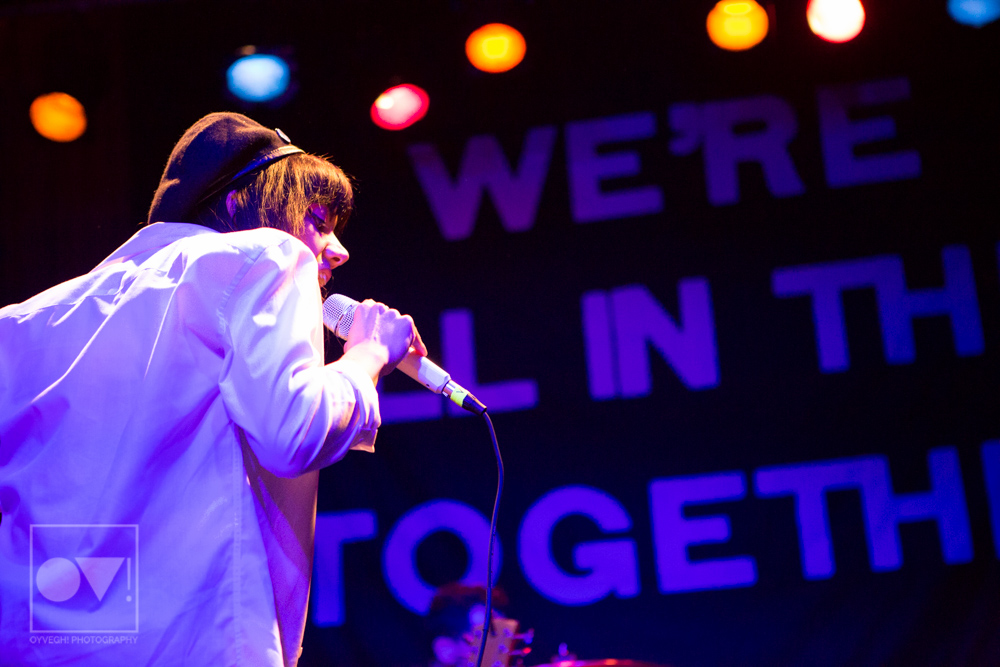Words by: Angela Bilancini
Photos by: Judie Vegh
A record or a show might seem like a scrawny thing in the face of a Drumpf presidency. Yet hearing Hurray for the Riff Raff’s Alynda Segarra – who sounded on this tour like she believed every word she’s singing, like she’s tapping into a new, vital self – is powerful.
She has been critical of the failure of folk-rock artists of her generation to infuse their work with political thought and activism, but her current album and tour don’t disappoint on that front.
 Hurray for the Riff Raff played at the Beachland Ballroom in Cleveland on April 25. “We’re In This Together” was emblazoned in white on a black banner at the back of the stage. Near the beginning of Hurray for the Riff Raff’s set, Segarra spoke about not being divided by the current American political climate and being unafraid to be hopeful about the future. In a white oxford, black spandex leggings, winged eyeliner, and a black beret with a peace-sign button affixed, she projected a calm confidence but you still got the feeling that there was a lot of interesting things going on behind her placid exterior.
Hurray for the Riff Raff played at the Beachland Ballroom in Cleveland on April 25. “We’re In This Together” was emblazoned in white on a black banner at the back of the stage. Near the beginning of Hurray for the Riff Raff’s set, Segarra spoke about not being divided by the current American political climate and being unafraid to be hopeful about the future. In a white oxford, black spandex leggings, winged eyeliner, and a black beret with a peace-sign button affixed, she projected a calm confidence but you still got the feeling that there was a lot of interesting things going on behind her placid exterior.
There’s a lot going on in Hurray for the Riff Raff’s newest album, The Navigator, too. It’s a sci-fi concept album with a comic book superhero-like main character, Navita Milagros Negron, who crisscrosses the country, travels through time, and finally returns to a home she doesn’t recognize but must come to understand and reconnect with.
The line is blurry between Navita, the inner navigator leading her, and Segarra herself, whose life is paralleled and mirrored in the events of the album.
She left her home and her Puerto Rican family in New York City at age 15 and rode trains across the country, ending up in New Orleans and forming Hurray for the Riff Raff there. Now age 30, she’s back in New York after a long stretch in New Orleans and a brief time in Nashville, coming to terms with the changes in her hometown – the gentrification, the displacement of the poor and working class, the intersection of race and culture and class in the city, and the changes in the Puerto Rican community she grew up with.
Segarra’s vocals are warm, honeyed, and usually measured. On previous Hurray for the Riff Raff albums, she sounds very much in control of how much emotion she’s going to share with her audience. But something changes over the course of this new album. By the final tracks, she’s let her voice unfurl. It’s moving to hear it happen on the recorded version of “Pa’lante” (an affirmation meaning “onwards”) — and the live version performed in Cleveland was no less affecting:
“To all who had to hide, I say Pa’lante!
To all who lost their pride, I say Pa’lante!
To all who had to survive, I say Pa’lante!”
Hurray for the Riff Raff’s The Navigator grows out of Segarra’s earlier work but she weaves in bomba rhythms and Puerto Rican poets.
 Over the course of the album, her character Navita changes as well, guided by the navigator to incorporate her past so she can move forward wisely and with pride. Segarra has a soulful quality, too. She wrote in Spin that, “There’s also the idea of the Navigator being like a spiritual guide, or this inner wisdom that we all have and try to suppress. I look back on the years when I was traveling when I was 17 and I wonder how I survived that. I believe there was some kind of angel looking out for me, or some kind of voice.”
Over the course of the album, her character Navita changes as well, guided by the navigator to incorporate her past so she can move forward wisely and with pride. Segarra has a soulful quality, too. She wrote in Spin that, “There’s also the idea of the Navigator being like a spiritual guide, or this inner wisdom that we all have and try to suppress. I look back on the years when I was traveling when I was 17 and I wonder how I survived that. I believe there was some kind of angel looking out for me, or some kind of voice.”
Hurray for the Riff Raff played much of the album during their Cleveland set, starting out with “Life to Save,” the sweet “Nothing’s Gonna Change That Girl,” “Hungry Ghost,” a stellar “Rican Beach,” “Settle,” Segarra on the piano for the stark “Fourteen Floors,” “Living In the City,” and “Pa’lante,” interspersed with strong older material: “Lake of Fire,” “Blue Ridge Mountain,” “The Body Electric,” “Good Time Blues (An Outlaw’s Lament,” and “St. Roch Blues.” They finished their encore by bringing Ron Gallo back onstage to cover John Lennon’s “Bring On The Lucie (Freda People).”
It’s a time when simple ideas about communication, expression, and free speech seem endangered and when their protection is essential.
Segarra’s current project of finding pride in her history and healing herself and her community with art feels like solace.

























